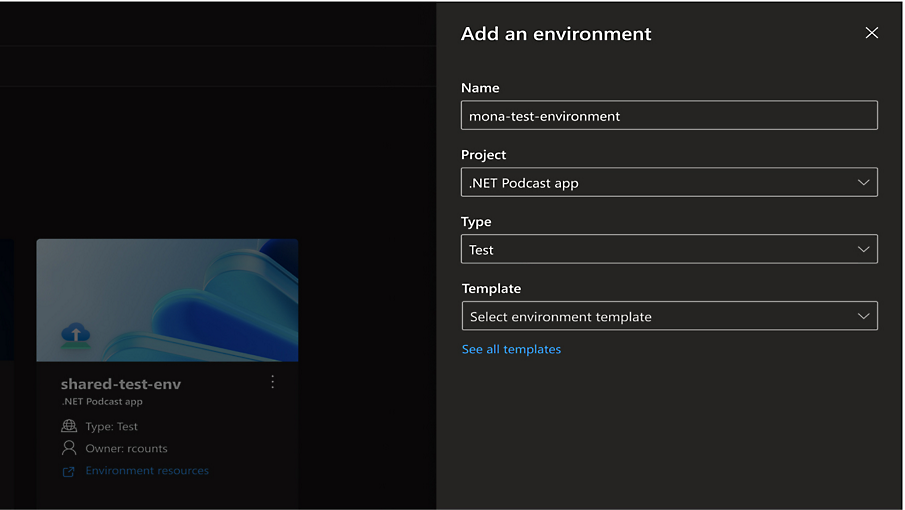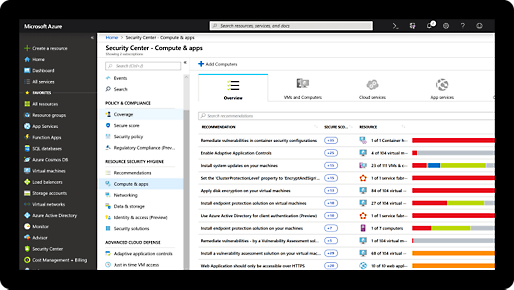Azure Deployment Environments
Quickly spin up app infrastructure environments with project-based templates.
Accelerate the development lifecycle with on-demand, preconfigured environments
Azure Deployment Environments provides devs with self-service, project-based templates to deploy environments for any stage of development. Support collaboration and innovation with consistent environments and best practices, and encourage experimentation and InnerSource use while maximizing security, compliance, and cost efficiency.
Easy, on-demand deployment from the dev portal, the CLI, or continuous integration and continuous delivery (CI/CD) pipelines
Standardized templates to help teams drive InnerSource best practices, tips, and tricks while eliminating overhead
Environment types set up by admins for a self-service dev experience while maintaining centralized governance
Comprehensive management capabilities to track and control costs and centrally manage Azure resources across dev centers
Enable a frictionless developer experience
Deploy the right environment at the right time without worrying about backend processes. Provision complex environments in minutes without waiting for your platform engineering team by choosing from a curated set of templates built specifically for your projects. Spin up self-service environments directly from where you work—including the code repository, the CLI, or a custom dev portal—while automatically applying the right identities, permissions, and Azure subscriptions.


Maximize security with centralized control
Enable platform engineering teams to configure security policies and permissions based on the stage of development. Ramp up protections for pre-production and production environments while supporting experimentation in dev/test and sandbox environments. Easily track resource usage across teams by automatically deploying resources in the right Azure subscription, and avoid unnecessary costs by setting environments to auto-expire when they are no longer needed.
Innovate and collaborate with standardized templates
Streamline cross-team workflows by creating infrastructure-as-code templates in the framework of your choice with Azure Deployment Environments’ extensibility model, and standardize environments while empowering devs to iterate and share best practices. Automatically deploy environments as part of an existing continuous integration and continuous delivery (CI/CD) pipeline or deploy on demand to test applications and sandbox environments to work on proof of concepts.

Comprehensive security and compliance, built in
-
Microsoft invests more than USD1 billion annually on cybersecurity research and development.

-
We employ more than 3,500 security experts who are dedicated to data security and privacy.

-
Use Azure Deployment Environments and pay only for Azure resources
Pay only for the Azure resources you create in your environments, such as compute, storage, and networking. Visual Studio subscribers can save up to 50 percent using Azure dev/test pricing with Azure Deployment Environments to support ongoing development and test needs.
Get started with an Azure free account
1

2

After your credit, move to pay as you go to keep building with the same free services. Pay only if you use more than your free monthly amounts.
3

Azure Deployment Environments resources and documentation
Learn more about Azure Deployment Environments
Frequently asked questions about Azure Deployment Environments
-
Environments and the associated Azure resources are created in customer subscriptions, as preconfigured for the specific project or team.
-
Thanks to Azure Deployment Environment's extensibility model (now in public preview), customers can leverage their preferred IaC framework to deploy through the service. This includes Azure Resource Manager, Bicep and popular IaC frameworks such as Terraform, Pulumi, and more.
-
Azure Deployment Environments helps with both cost visibility and cost control. Dev infrastructure teams can easily track, manage, and govern environments created by development teams. Additionally, dev infrastructure teams will be able to view the security alerts and costs incurred per environment across teams and organizations. To make cost management easier, developers and admins can set environments to auto-delete when they are no longer needed.
